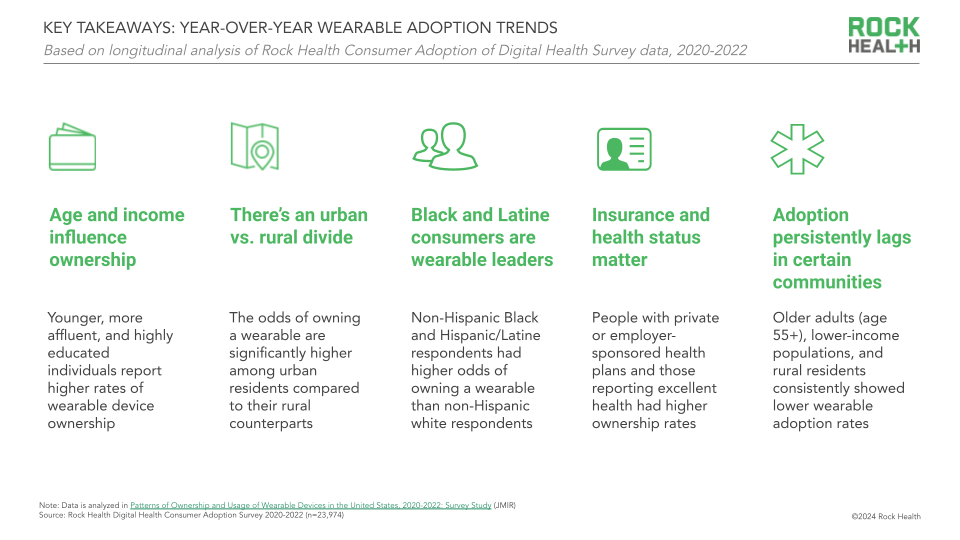Put a ring on it: Understanding consumers’ year-over-year wearable adoption patterns
Wearable technology has made big inroads into our daily lives. According to the 2023 Rock Health Digital Health Consumer Adoption Survey, 44% of Americans own wearable health tracking devices such as smartwatches or smart rings, tracking health metrics from sleep to heartbeat patterns. At scale, wearable device ownership can also support public health efforts.
In a recent study published in the Journal of Medical Internet Research (JMIR), we analyzed three years (2020-2022) of Rock Health Digital Health Consumer Adoption Survey (hereafter referred to as the “Survey”) data to offer a longitudinal perspective on how wearable device ownership and usage has evolved in the U.S., with deep-dive analyses across sociodemographic groups. With nearly 24,000 respondents surveyed across those three years, findings from our large-scale, U.S. Census-matched survey series can help guide more equitable design practices and go-to-market strategies among wearable device makers and distributors.1
Some key takeaways from our analysis of 2020-2022 Survey data:
- Age and income influence ownership: Younger, more affluent, and highly educated individuals report higher rates of wearable device ownership.
- There’s an urban vs. rural divide: The odds of owning a wearable are significantly higher among urban residents compared to their rural counterparts. This disparity highlights ongoing barriers to wearable access in rural areas, despite the fact that these devices can help to remotely monitor patients without easy access to specialized care.
- Black and Latine consumers are wearable leaders: While wearable ownership patterns varied across racial and ethnic groups, non-Hispanic Black and Hispanic/Latine respondents had higher odds of owning a wearable than non-Hispanic white counterparts.
- Insurance and health status matter: Individuals with private or employer-sponsored insurance and those reporting excellent health reported higher ownership rates. This finding indicates that employed and “worried-well” consumers are leading wearable adoption.
- Adoption persistently lags in certain communities: Older adults (age 55+), lower-income populations, and rural residents consistently showed lower adoption rates. Addressing these gaps is essential for device makers, both to grow their consumer base and to improve equitable access to the health benefits of wearable technology.

These longitudinal findings have important implications for wearable device makers, as well as the healthcare providers, employers, insurers, pharma companies, diagnostic players, and other companies that partner with them. First, they highlight the importance of including fully representative groups in wearable design processes and feedback sessions—tailored marketing strategies and product designs are needed to reach underrepresented populations. They also underscore the power of partnering with large healthcare organizations to use their scale to expand awareness of and access to wearables. Last, they emphasize that broader marketing and outreach efforts are needed to help all consumers understand the value that wearables could provide in their daily lives, such as improved at-home safety and visibility into changing health patterns.
For more, read the published article in JMIR.
Tap into wearable insights and strategic guidance for how to expand your wearable partnership strategy with Rock Health Advisory.
Get in touch with the venture team at Rock Health Capital.
Join us in building a more equitable future at RockHealth.org.
And last but not least, stay plugged into the Rock Health community and all things digital health with the Rock Weekly.
Footnotes
- Survey respondents are Census-matched by gender, age, U.S. region, race/ethnicity, and annual household income.


